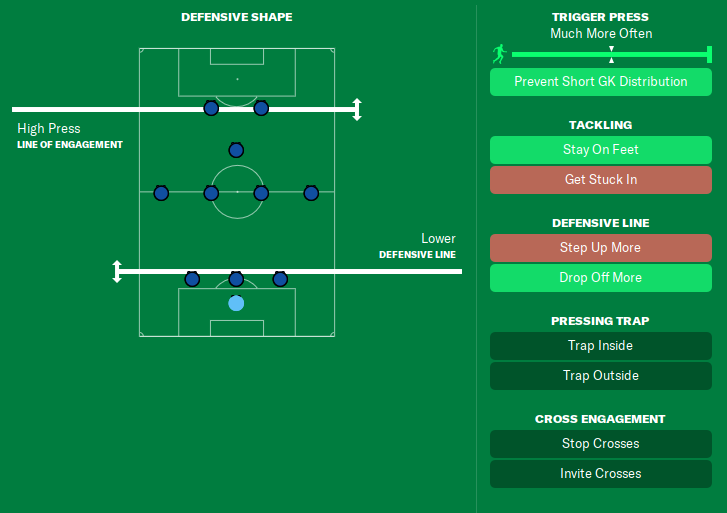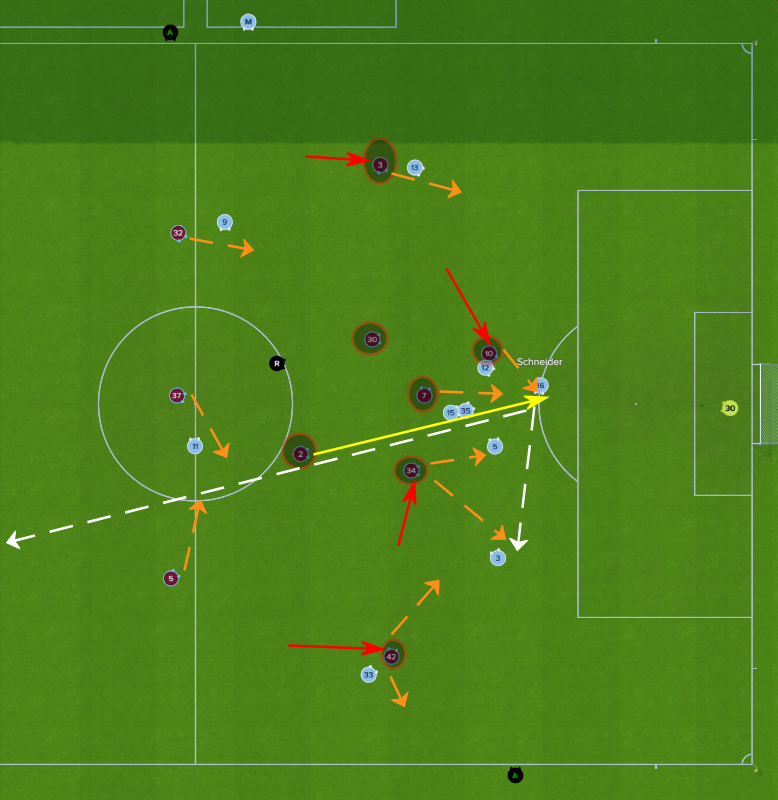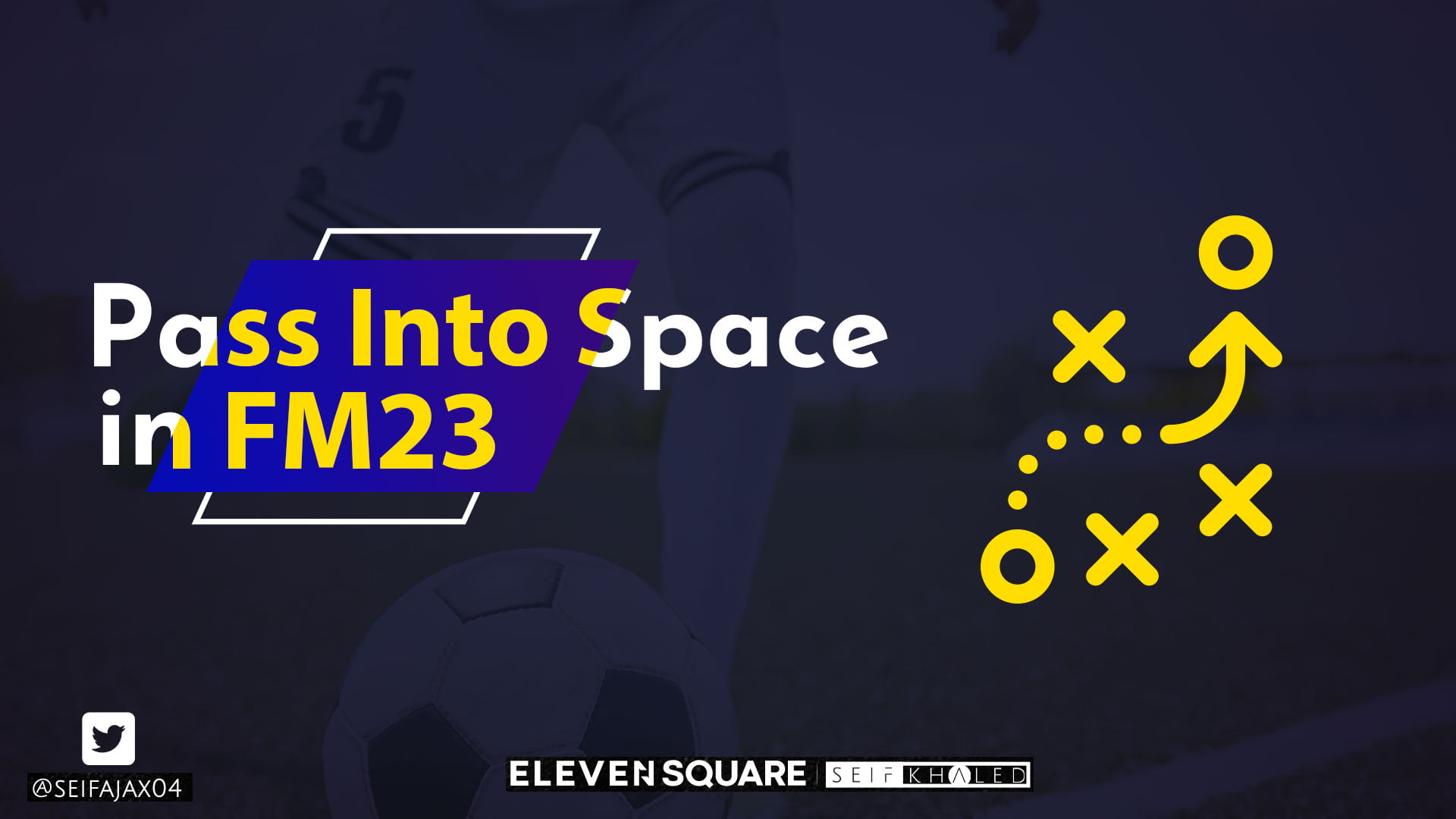As you prepare your team’s instructions in Football Manager, you’ll come across a prominent button labeled “Pass into Space” positioned at the top of the In-possession instructions.
This button allows you to tactically instruct your players to make more direct and incisive passes, seeking to exploit open spaces ahead of attacking players. By clicking “Pass into Space,” you encourage your team to adopt a more aggressive and forward-thinking passing style, which can be especially advantageous if you have quick and agile attackers capable of capitalizing on these opportunities.
However, remember to assess your team’s strengths and weaknesses, consider the opposition’s tactics, and evaluate the match situation before applying this instruction or any other tactical choices in Football Manager. A thoughtful approach and experimentation will help you find the most effective strategy for your team’s success.
What does it mean [Pass Into Space] in fm23?
“Pass Into Space” instructs your players to look for opportunities to make more direct passes into open spaces ahead of attacking players. It encourages a more aggressive and forward-thinking style of passing, seeking to exploit spaces behind the opposition’s defensive line. This can be particularly effective if you have fast and mobile attacking players who can capitalize on those passes.
By using “Pass Into Space,” your team may attempt longer and more incisive passes, attempting to create one-on-one situations or goal-scoring opportunities. However, it also carries some risks, as more direct passes can be intercepted by the opposition if not executed properly.
As with any tactical instruction in Football Manager, it’s essential to consider your team’s strengths and weaknesses, the opposition’s tactics, and the match situation when deciding whether to use “Pass Into Space” or other instructions. Experimenting with different tactics and observing their impact during matches can help you find the most effective approach for your team in FM23.

When do you tick ”pass into space”?
You should consider using “Pass Into Space” in Football Manager when you want your team to adopt a more direct and aggressive style of play, with an emphasis on exploiting open spaces ahead of your attacking players. Here are some situations where using “Pass Into Space” could be beneficial:
- Fast and Agile Attackers: If your team has quick and skillful forwards who excel at making runs behind the opposition’s defensive line, “Pass Into Space” can be highly effective. It allows your players to deliver incisive through balls and passes that your speedy attackers can chase down and capitalize on.
- Exploiting High Defensive Lines: When your opponents play with a high defensive line, there may be more space behind their defenders. In such situations, instructing your players to “Pass Into Space” can help you exploit those gaps and create scoring opportunities.
- Counter-Attacking Strategy: If you prefer a counter-attacking style of play, “Pass Into Space” can be a useful instruction. It enables your team to quickly transition from defense to attack by releasing fast passes into the spaces left open by the opposition’s advancing players.
- Breaking Defensive Blocks: Against teams that sit deep and maintain a compact defensive shape, using “Pass Into Space” can be a way to stretch their defense and find gaps to penetrate.
- Targeting Wing Play: If you have speedy wingers who can beat their markers for pace, “Pass Into Space” can be a great option. It allows your midfielders and full-backs to play balls into wide areas, giving your wingers more space to exploit.
- Late in a Match: When you need a goal late in a match, “Pass Into Space” can increase the urgency and directness of your attacks, making it more challenging for the opposition to defend against your aggressive offensive moves.
However, it’s important to use “Pass Into Space” judiciously and consider your team’s overall tactical setup. It may not be suitable for every match or every situation. Take into account your players’ abilities, the opposition’s tactics, and the flow of the game before deciding to use this instruction. Frequent use of “Pass Into Space” might lead to turnovers if your players are not accurate with their passes or if the opposition anticipates the play.
Remember, Football Manager is all about experimentation and adaptation. Observe how your team performs with and without “Pass Into Space” in different scenarios and fine-tune your tactics accordingly.
Tips before using pass into space?
Before using the “Pass Into Space” instruction in Football Manager, consider these tips to make the most of its effectiveness:
- Player Attributes: Ensure you have players with the right attributes to execute this style of play successfully. Look for attackers with good pace, off-the-ball movement, and anticipation to make well-timed runs into space. Midfielders and playmakers with high vision and passing accuracy will be essential for delivering accurate through balls.
- Opposition Analysis: Analyze the opposition’s defensive setup and identify areas of vulnerability where space is likely to be available. Look for gaps between defenders or instances when the opposition’s defensive line is high, leaving space in behind.
- Game Situation: Consider the match situation and whether “Pass Into Space” aligns with your overall tactical approach. It can be particularly effective when you want to catch the opposition on the break or exploit spaces left by an aggressive defensive line. However, in some situations, a more patient possession-based approach might be more suitable.
- Timing and Decision-making: Timing is crucial when playing passes into space. Instruct your players to release the ball at the right moment to lead the attacking player into space. Also, emphasize good decision-making, as attempting risky passes into space when the odds are unfavorable can lead to turnovers.
- Player Instructions: Complement “Pass Into Space” with other relevant player instructions. For example, you might instruct your attacking players to make more forward runs, or your full-backs to overlap and provide width, creating additional attacking options.
- Training and Familiarity: Work on the “Pass Into Space” instruction during training sessions to improve your team’s familiarity with this style of play. The more familiar your players are with the tactic, the better they will execute it during matches.
- Observe and Adapt: Keep a close eye on how your team performs with “Pass Into Space” in different matches. If you notice it’s not yielding the desired results, be prepared to adapt your tactics. Consider changing the instruction or adjusting other aspects of your tactical setup.
- Substitutions: Be mindful of your substitutions and how they might affect your tactics. Bringing on pacey and skilled attackers in the later stages of the match can be especially effective when using “Pass Into Space” to exploit tired defenses.
- Opponent’s Adaptation: Be aware that the opposition may adjust their defensive tactics to counter your use of “Pass Into Space.” Have alternative plans in place to respond to their changes and maintain your team’s effectiveness.
- Patience and Learning: Like any tactical approach, it may take time for your players to fully grasp and execute “Pass Into Space” effectively. Be patient, learn from both successes and failures, and be willing to make tactical adjustments as needed.
By considering these tips, you can increase the chances of success when implementing “Pass Into Space” and make your team a more potent attacking force in Football Manager.
Types of Passes Into Space
In football, there are several types of passes that can be played into space to exploit gaps in the opposition’s defense and create scoring opportunities. Some of the most common types of passes into space include:
- Through Ball: A through ball is a pass played between defenders, into open space behind the defensive line, for an attacking player to run onto. It requires precise timing and accuracy to split the defense and put the attacker in a one-on-one situation with the goalkeeper.
- Lobbed Through Ball: Similar to a regular through ball, but this pass is lofted over the defenders, allowing the attacking player to make a well-timed run to collect the ball as it drops behind the defense.
- Chip Pass: A chip pass is a high, lofted pass that is played over a short distance, often used to lift the ball over a defensive line and into the path of an onrushing teammate.
- Diagonal Ball: A diagonal pass is played at an angle across the field, often covering a long distance. It can be used to switch play to the other side of the pitch, exploiting spaces left by the opposition.
- Cross: A cross is a pass played from the flanks into the penalty area, aiming to find a teammate in a scoring position. It can be played along the ground or as a high, looping ball.
- Long Ball: A long pass played over a significant distance, usually from the defensive or midfield area to an advanced position on the field. This type of pass can quickly bypass the midfield and catch the opposition off-guard.
- Reverse Pass: A pass played with the inside of the foot, curling around the defender, and into space behind them. It’s a deceptive way to release a teammate into a more advanced position.
- Wall Pass (One-Two): A quick exchange of passes between two players, often used to maneuver around a defender and open up space for a return pass into the area vacated by the defender.
- Sliding Pass: A pass played along the ground, often executed with the outside of the foot, to slide the ball into space and avoid nearby defenders.
- Dummy Pass: A deceptive move where a player lets the ball pass through their legs without touching it, allowing a teammate behind them to collect the ball in space.
Each type of pass into space requires specific technical skills and a good understanding between players to execute effectively. Understanding when and how to use these passes can significantly enhance a team’s attacking prowess and ability to exploit defensive weaknesses.

What are the most effective formations with pass into space?
The effectiveness of the “Pass Into Space” instruction can be maximized with formations that prioritize quick, direct attacking play and provide sufficient attacking options to exploit the spaces created. While there is no single “best” formation, several formations tend to work well with the “Pass Into Space” style of play. Here are some formations to consider:
- 4-2-3-1 Formation: This formation offers a balanced approach with two central midfielders supporting attacking wingers and an advanced attacking midfielder. The lone striker up top can benefit from well-timed through balls into space behind the opposition’s defense.
- 4-3-3 Formation: A flexible formation with a midfield triangle, this setup allows for dynamic attacking movement. The three forwards, typically consisting of a center forward and two wingers, can exploit spaces with their speed and intelligent runs.
- 4-1-4-1 Formation: This formation provides a solid defensive foundation with a holding midfielder shielding the backline. The four midfielders ahead can create passing options and look to deliver incisive passes into space for the lone striker.
- 3-4-3 Formation: A more attacking formation with three center-backs and wing-backs providing width, this setup encourages the use of wide areas to stretch the opposition’s defense. The front three can benefit from quick passes into space.
- 4-2-4 Formation: A highly offensive formation with two central midfielders and four attacking players, this setup can overwhelm the opposition with quick passes and runs into space.
- 4-3-1-2 Formation: A narrow formation that can exploit central spaces, particularly between opposition defenders and midfielders. The attacking midfielder behind the two strikers can play decisive through balls.
Remember, the success of any formation depends on how well it complements your team’s strengths, playing style, and the opposition you face. Additionally, player roles, individual player instructions, and team mentality are vital aspects to consider when using “Pass Into Space” with a specific formation. Regularly assess and fine-tune your tactics based on your team’s performance and the opponents you encounter to achieve the best results.
How to Defend Passes Into Space in fm23?
- Tactical Setup: Set up your team with a solid defensive formation and strategy. Consider using a formation that offers good coverage of the defensive areas and ensures players are positioned to limit spaces for opponents to exploit.
- Player Instructions: Customize player instructions based on your tactical approach. You can instruct defenders to mark tightly, close down quickly, and stay on their feet to avoid diving into tackles unnecessarily.
- Pressing Triggers: Define specific pressing triggers in your tactics to encourage your players to press the opposition when they are about to receive a pass. Pressing at the right moment can disrupt the flow of the opposition’s passing game.
- Defensive Line: Adjust your defensive line appropriately. A lower defensive line in football manager asks the defence to play closer to their own goal, holding a more compact shape to prevent the opposition from making gains in the space behind them.
- Midfield Screening: Utilize a defensive midfielder or central midfield duo to provide additional cover in front of your defense. This player can help cut off passing lanes and prevent through balls.
- Offside Trap: Implement the offside trap when appropriate. Timing is critical, and a well-executed offside trap can catch opponents in offside positions when they attempt to run into space behind your defensive line.
- Teamwork and Communication: Good defensive performances rely on effective teamwork and communication. Encourage your players to work together, communicate on the pitch, and cover for each other when necessary.
- Adapt and Observe: Analyze matches and the opposition’s tactics. Observe how your team defends against passes into space and make tactical adjustments accordingly.

Why should Using Pressing Triggers to Defend Passes Into Space in fm23?
Establishing a mid-block line of engagement while instructing your players to trigger the press more frequently can be an effective tactic. In this system, your players will actively work to disrupt the opposition’s playmakers and limit their ability to execute long balls.
The concept is straightforward: increased pressing leads to a reduction in long balls from the opposition, which, in turn, decreases the number of attacking threats your team faces.
By striking the right balance between pressing and defensive organization, you can stifle the opposition’s attempts to launch long balls and mitigate potential attacking dangers. This strategic approach can significantly impact the flow of the game in your team’s favor.

Stay tuned for more Football Manager tactical guides like this, where we delve into the intricacies of the game and explore various strategies to elevate your managerial prowess. With a plethora of tactical options at your disposal, there’s always something new to learn and master in the world of Football Manager. So, continue to refine your tactics, experiment with different styles of play, and lead your team to glory on the virtual pitch. Until next time, may your passes into space lead to mesmerizing attacking plays and unforgettable moments in the beautiful game of Football Manager 😊


Published by